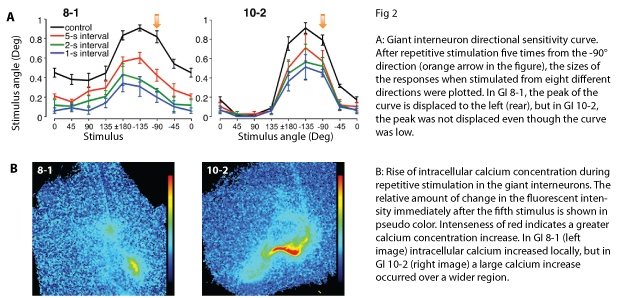Elucidation of a Neuronal Mechanism for Distinguishing Between a Prior Stimulus and a Novel Stimulus
Research Press Release | October 05, 2015
| Press Release | ||
|---|---|---|
| Key Points | ・ Discovery that crickets show direction-specific adaptation with regard to repetitively provided air current stimuli.
・ Discovery that repetitive air current stimuli shift the directional sensitivity of wind-sensitive giant interneurons. ・ Discovery that calcium ions that increase locally within the cell cause the directional sensitivity shift. |
|
| Overview |
Stimulus-specific adaptation (SSA) is considered to be the neural underpinning of habituation to repeated stimuli and of the detection of only novel stimuli. We discovered that when crickets are stimulated by a repetitive air current from the same direction, they show a greater response to air currents from different directions rather than to the air current of the repetitive stimulus. Similar stimuli decreased the response of giant interneurons that govern wind-elicited avoidance behavior and changed directional sensitivity (the direction in which the response is larger). As a result of pharmacological experiments and calcium imaging experiments, we learned that within giant interneurons, calcium increases intensively at places where the information of repeated stimuli is input, and so the response is specifically weakened. Terms: Spike firing response: A rapid change in the potential across the cell membrane that occurs when a neuron reacts to a stimulus or when information is transmitted between the neurons is called an “action potential” or a “spike”. Information such as the strength of a stimulus is often expressed by the spike frequency (Hz). |
|
| Inquiries |
Hiroto OGAWA, Behavioral Physiology, Department of Biological Sciences, Faculty of Science, Hokkaido University TEL & FAX: +81-11-706-3525 E-mail: hogawa@sci.hokudai.ac.jp |
|
|
Japanese Link |
古い刺激と新しい刺激を区別する神経細胞メカニズムを解明 (2015.8.20) | |
| Publications | Direction-specific adaptation in neuronal and behavioral responses of an insect mechanosensory system , Journal of Neuroscience (2015.8.19) | |


